Zoetis Bundle
Who Really Calls the Shots at Zoetis?
Understanding the ownership structure of a company like Zoetis is key to grasping its strategic direction and market influence. From its roots as part of Pfizer to its current status as a global leader in animal health, Zoetis's journey offers a fascinating case study in corporate evolution. Knowing Zoetis SWOT Analysis can help you understand its strengths and weaknesses.
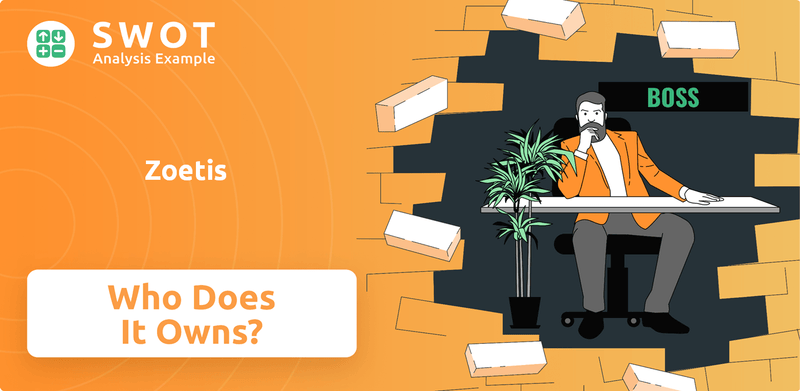
Zoetis, once a division of Pfizer, now operates independently, making its ownership a critical factor for investors and stakeholders. The shift to public ownership has significantly impacted Zoetis's operations, from its research investments to its global expansion strategies. This exploration dives into the evolution of Zoetis ownership, examining its history, key institutional investors, and the composition of its board of directors, revealing how the Zoetis company is shaped by its diverse shareholder base, impacting Zoetis stock performance.
Who Founded Zoetis?
The story of Zoetis, a leading animal health company, doesn't begin with individual founders in the traditional sense. Instead, its roots are firmly planted within the corporate structure of Pfizer Inc. Zoetis emerged from Pfizer's agricultural division, later known as Pfizer Animal Health, in 1952. This means the early ownership was entirely within Pfizer's control.
Therefore, there were no individual founders with specific equity stakes or initial shareholdings. Pfizer, as the parent company, provided the initial capital, resources, and strategic direction for the animal health business. The evolution of Zoetis reflects a strategic shift within Pfizer, rather than a startup with founders seeking investment.
The early phase of Zoetis involved no external investors or early-stage funding rounds. All investment decisions were made at the Pfizer corporate level, aligning with Pfizer's overall business strategy. This model meant there were no vesting schedules, buy-sell agreements, or founder exits in the typical startup manner, as the 'founding team' was essentially Pfizer's corporate management overseeing the animal health segment. The vision for the animal health division was integrated into Pfizer's broader mission, focusing on leveraging pharmaceutical expertise for animal well-being.
Zoetis was established in 1952 as Pfizer's agricultural division, later known as Pfizer Animal Health.
There were no individual founders with specific equity percentages or shareholdings at the beginning.
Pfizer, as the parent company, provided initial capital, resources, and strategic direction.
Decisions regarding investment and growth were made at the Pfizer corporate level.
There were no vesting schedules, buy-sell clauses, or founder exits in the conventional sense.
The animal health division's vision was integrated into Pfizer's broader mission.
Understanding the origins of Zoetis's mission as a division of Pfizer provides crucial context for its ownership structure. The absence of traditional founders and early-stage investors is a key characteristic of the company's history. The focus was on leveraging pharmaceutical expertise for animal well-being.
- Zoetis's early ownership was entirely within Pfizer's corporate structure.
- There were no individual founders with specific equity or shareholdings.
- Pfizer provided the initial capital, resources, and strategic direction.
- All investment decisions were made at the Pfizer corporate level.
- The 'founding team' was essentially Pfizer's corporate management.
Zoetis SWOT Analysis
- Complete SWOT Breakdown
- Fully Customizable
- Editable in Excel & Word
- Professional Formatting
- Investor-Ready Format
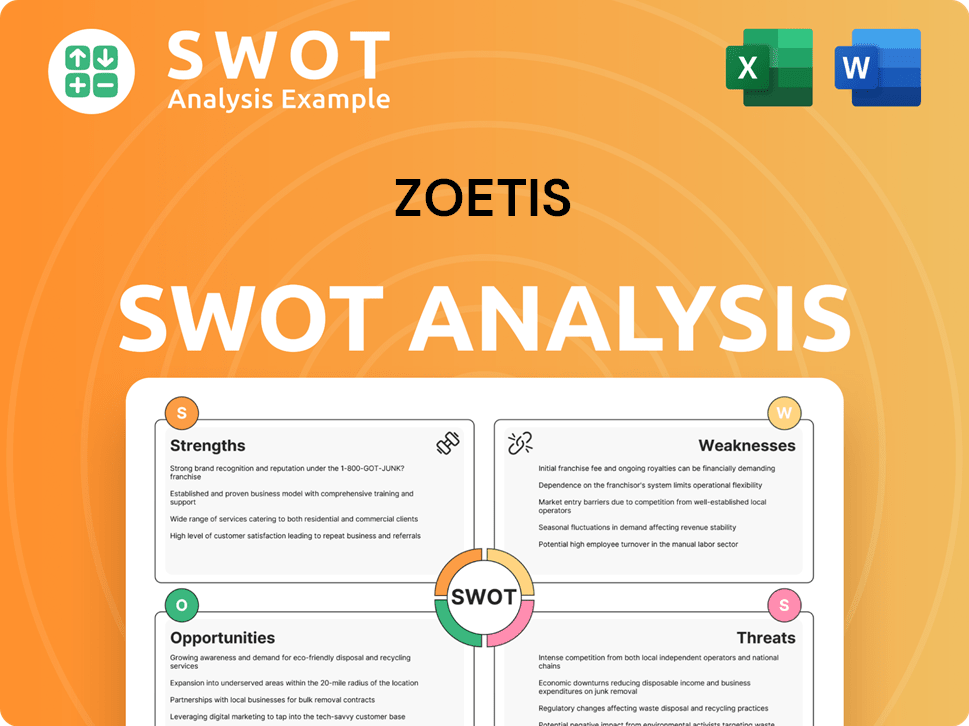
How Has Zoetis’s Ownership Changed Over Time?
The most significant change in the Zoetis's ownership structure occurred in February 2013 with its initial public offering (IPO). This event marked a pivotal moment, as Pfizer Inc. spun off Zoetis, initially selling approximately 83% of its stake. The IPO, one of the largest of 2013, raised around $2.2 billion, with shares priced at $26.00 each. Following the IPO, Pfizer gradually divested its remaining shares, completing its exit by June 2013. This transformation converted Zoetis from a wholly-owned subsidiary into an independent, publicly traded company.
Since its IPO, Zoetis's ownership has been primarily held by a diverse group of institutional investors, mutual funds, and individual shareholders. The shift to public ownership has significantly impacted Zoetis's strategy and governance, allowing it to pursue its own strategic initiatives in the animal health market. This included research and development, acquisitions, and global expansion, free from Pfizer's broader corporate priorities. For more insights, you can explore the Brief History of Zoetis.
| Shareholder | Percentage of Shares (as of March 31, 2025) | Notes |
|---|---|---|
| The Vanguard Group Inc. | 8.92% | Largest institutional shareholder. |
| BlackRock Inc. | 7.56% | Second-largest institutional shareholder. |
| State Street Corp. | 4.29% | Significant institutional holding. |
| Capital World Investors | 3.86% | Key institutional investor. |
As of late 2024 and early 2025, major institutional shareholders, such as The Vanguard Group Inc. and BlackRock Inc., held substantial portions of Zoetis stock. These institutional holdings indicate a broad base of professional investment management, influencing the company's focus on long-term growth and shareholder value. Understanding Zoetis ownership is crucial for investors interested in Zoetis stock and the company's future.
Zoetis's ownership structure has evolved significantly since its IPO in 2013, transitioning from a subsidiary of Pfizer to a publicly traded company.
- Major institutional investors like The Vanguard Group Inc. and BlackRock Inc. hold significant shares.
- The shift to public ownership has enabled Zoetis to pursue independent strategic initiatives.
- Understanding Zoetis ownership is essential for anyone investing in Zoetis pharmaceuticals.
- The company's focus is on long-term growth and shareholder value.
Zoetis PESTLE Analysis
- Covers All 6 PESTLE Categories
- No Research Needed – Save Hours of Work
- Built by Experts, Trusted by Consultants
- Instant Download, Ready to Use
- 100% Editable, Fully Customizable
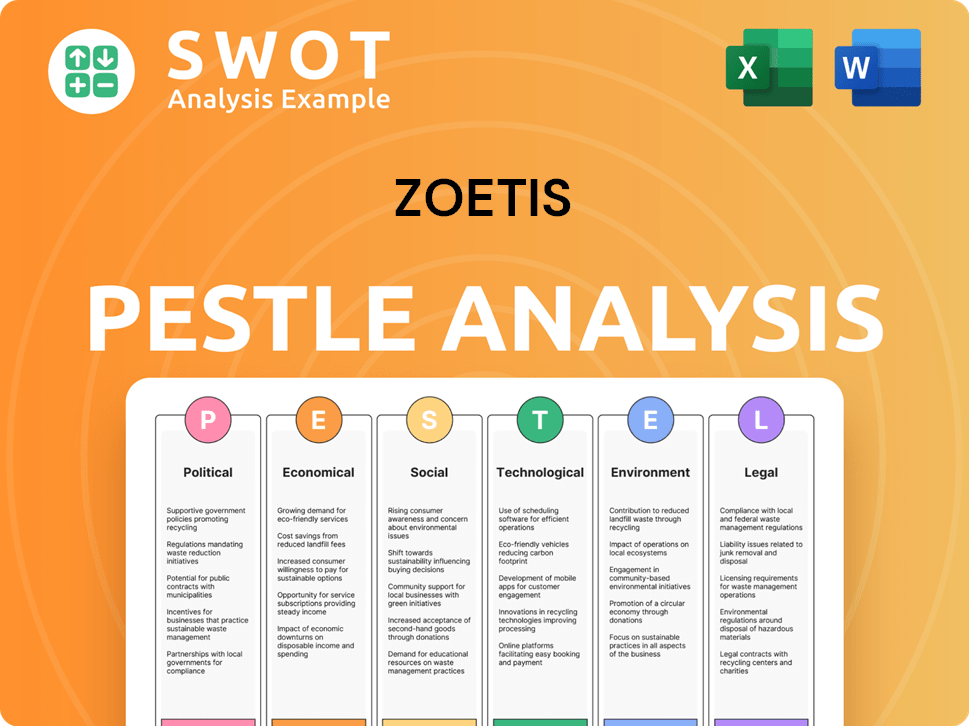
Who Sits on Zoetis’s Board?
The current board of directors of Zoetis Inc. plays a crucial role in the company's governance, representing the interests of its shareholders. As of April 2025, the board includes a mix of independent directors and those with significant industry experience. Kristin C. Peck serves as the Chief Executive Officer and is a member of the board, providing executive insight. Other board members often have backgrounds in finance, pharmaceuticals, animal health, and global business. This ensures a broad range of perspectives to guide the company's strategic direction. Understanding the composition of the board is key to understanding the dynamics of Zoetis ownership and governance.
The board's oversight is designed to ensure a balance of expertise and independent oversight. While specific individuals representing major shareholders like Vanguard or BlackRock are not typically listed as direct board members, their influence is felt through the board's decisions. The board's focus remains on driving long-term value for its shareholders through strategic growth and operational excellence in the animal health sector. This structure promotes a more democratic governance model where institutional investors, with their substantial holdings, collectively exert significant influence through their voting power.
| Board Member | Title | Relevant Experience |
|---|---|---|
| Kristin C. Peck | Chief Executive Officer | Executive leadership, animal health industry |
| Independent Directors | Various | Finance, pharmaceuticals, global business |
| Other Board Members | Various | Animal health, industry-specific expertise |
The voting structure for Zoetis is generally based on a one-share-one-vote principle. This means that each share of common stock carries one vote, ensuring that voting power is directly proportional to ownership stake. This is a common practice for publicly traded companies in the United States. There are no indications of dual-class shares or special voting rights that would grant outsized control to specific individuals. This structure promotes a more democratic governance model.
The board of directors at Zoetis oversees the company's strategic direction, ensuring a balance of expertise and independent oversight. The voting structure follows a one-share-one-vote principle. Learn more about Revenue Streams & Business Model of Zoetis.
- The board includes the CEO and independent directors.
- Voting power is proportional to share ownership.
- No significant proxy battles have been reported recently.
- The board focuses on long-term shareholder value.
Zoetis Business Model Canvas
- Complete 9-Block Business Model Canvas
- Effortlessly Communicate Your Business Strategy
- Investor-Ready BMC Format
- 100% Editable and Customizable
- Clear and Structured Layout
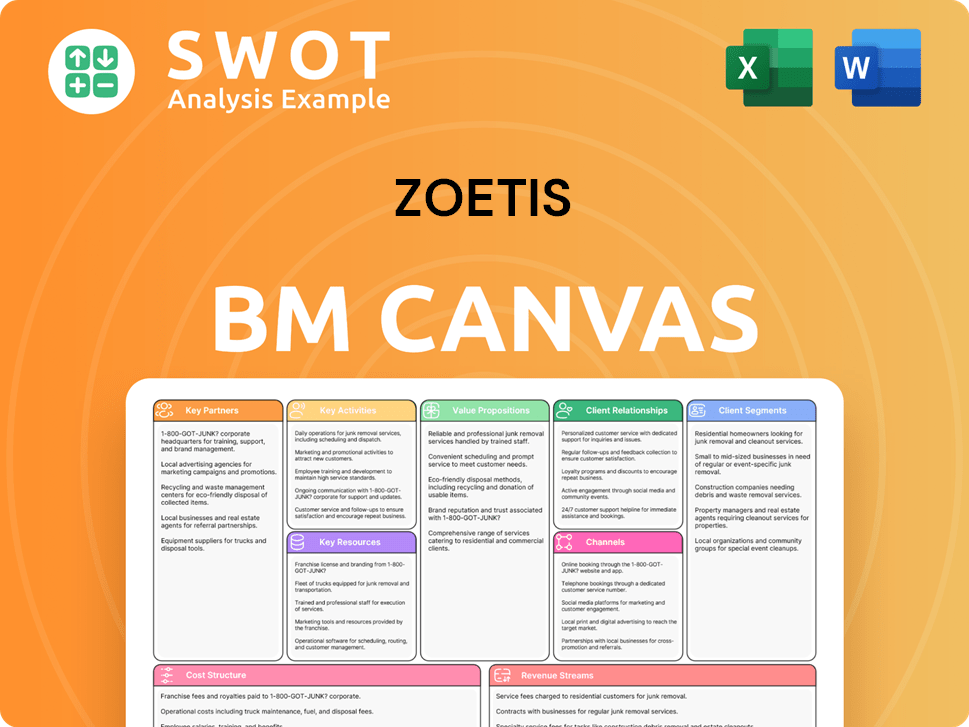
What Recent Changes Have Shaped Zoetis’s Ownership Landscape?
Over the past few years, the Zoetis ownership structure has remained largely consistent, with a significant portion of shares held by institutional investors. This reflects broader market trends where institutional ownership dominates. The company has not announced any major share buybacks or secondary offerings that would substantially alter its ownership composition. Zoetis continues to focus on strategic acquisitions to expand its product portfolio and market reach. For instance, the acquisition of Jurox in 2021 helped strengthen its presence in the Australasian animal health market.
The influence of passive index funds and large asset managers, such as Vanguard and BlackRock, is notable. These firms, due to their substantial assets under management, naturally accumulate significant stakes in major corporations like Zoetis, leading to a more consolidated institutional ownership base. Leadership changes, such as executive retirements, have had minimal impact on the overall institutional ownership landscape. The company's strategic focus includes organic growth, acquisitions, and returning value to shareholders through dividends and potential share repurchases, depending on market conditions.
| Metric | Value | Year |
|---|---|---|
| Institutional Ownership | Approximately 80% | 2024 |
| Market Capitalization | Approximately $80 billion | 2024 |
| Annual Revenue | Approximately $8.5 billion | 2023 |
Looking forward, Zoetis is expected to maintain its public listing status, with ownership remaining dispersed among institutional and individual investors. The company's governance structure is designed to support long-term growth within the animal health industry. For more detailed information on the company, you can refer to this article about Zoetis.
Institutional investors, including mutual funds and pension funds, hold a significant portion of Zoetis shares. These investors often have a long-term investment horizon, influencing the company's strategic decisions. Their substantial holdings contribute to the stability of the stock.
The ownership structure of Zoetis has remained relatively stable in recent years. There have been no major shifts in ownership that would suggest significant changes in the company's direction. This stability is a positive sign for investors.
Zoetis has been actively pursuing strategic acquisitions to expand its product portfolio and market reach. These acquisitions are a key part of the company's growth strategy. The company's focus is on both organic growth and strategic acquisitions.
Zoetis is committed to returning value to shareholders through dividends and potential share repurchases. These actions reflect the company's confidence in its financial performance. This focus on shareholder value is a key aspect of its strategy.
Zoetis Porter's Five Forces Analysis
- Covers All 5 Competitive Forces in Detail
- Structured for Consultants, Students, and Founders
- 100% Editable in Microsoft Word & Excel
- Instant Digital Download – Use Immediately
- Compatible with Mac & PC – Fully Unlocked
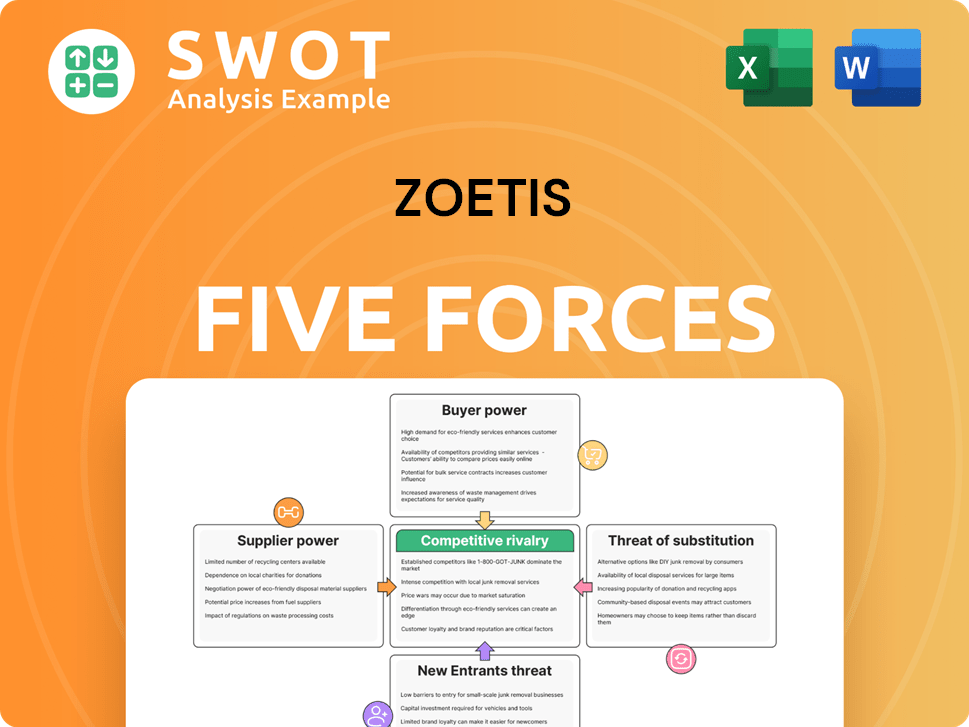
Related Blogs
- What are Mission Vision & Core Values of Zoetis Company?
- What is Competitive Landscape of Zoetis Company?
- What is Growth Strategy and Future Prospects of Zoetis Company?
- How Does Zoetis Company Work?
- What is Sales and Marketing Strategy of Zoetis Company?
- What is Brief History of Zoetis Company?
- What is Customer Demographics and Target Market of Zoetis Company?
Disclaimer
All information, articles, and product details provided on this website are for general informational and educational purposes only. We do not claim any ownership over, nor do we intend to infringe upon, any trademarks, copyrights, logos, brand names, or other intellectual property mentioned or depicted on this site. Such intellectual property remains the property of its respective owners, and any references here are made solely for identification or informational purposes, without implying any affiliation, endorsement, or partnership.
We make no representations or warranties, express or implied, regarding the accuracy, completeness, or suitability of any content or products presented. Nothing on this website should be construed as legal, tax, investment, financial, medical, or other professional advice. In addition, no part of this site—including articles or product references—constitutes a solicitation, recommendation, endorsement, advertisement, or offer to buy or sell any securities, franchises, or other financial instruments, particularly in jurisdictions where such activity would be unlawful.
All content is of a general nature and may not address the specific circumstances of any individual or entity. It is not a substitute for professional advice or services. Any actions you take based on the information provided here are strictly at your own risk. You accept full responsibility for any decisions or outcomes arising from your use of this website and agree to release us from any liability in connection with your use of, or reliance upon, the content or products found herein.